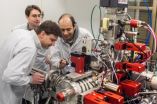(Press-News.org) This press release is available in German.
The microbiology team of David Berry, Alexander Loy and Michael Wagner from the Faculty of Life Sciences, in collaboration with scientists at the Max F. Perutz Laboratories (University of Vienna and the Medical University of Vienna) and with the help of NanoSIMS technology, has for the first time succeeded in directly observing microorganisms feeding on the intestinal mucosa. The results of this research project appear in the current issue of the prestigious journal "Proceedings of the National Academy of Sciences" (PNAS).
To understand the research project by Michael Wagner and his team, one must be ready to follow the microbiologists into the depths of mouse intestine. Michael Wagner, Professor for Microbial Ecology, provides this analogy: "Much like cows grazing in a meadow, intestinal bacteria can feed on mucus secreted by the mucosal tissue. There are a group of microorganisms that do not nourish themselves from mouse food, but rather are specialized in feeding on the secreted products of their host." The intestinal mucus layer is a vital barrier to block pathogenic microorganisms from entering the body and also plays a major role in inflammatory bowel disease. That is why scientists are very interested to know which bacteria inhabit the mucus layer in healthy organisms and thus may suppress the colonization and degradation of this barrier by pathogens.
Cooperation: Department of Microbial Ecology and Max F. Perutz Laboratories
The team led by Michael Wagner and Alexander Loy wanted to know as part of their activities supported by the Austrian Genome Research Program GEN-AU: Which organisms in healthy mice consider the mucosa and intestinal mucus layer a delicacy? "We've come up with an experimental setup that allows us for the first time to look into the intestine and directly observe organisms grazing on the mucus and measure how much mucus they have taken up," said team leader Alexander Loy from the Department of Microbial Ecology, University of Vienna. To do this, the microbiologists in collaboration with the teams of Thomas Decker, Department of Microbiology, Immunobiology and Genetics at the Max F. Perutz Laboratories and Bärbel Stecher of the University of Munich, labeled an amino acid with stable isotopes that once in the bloodstream mostly ends up in the mucus. Wagner explains, "It became clear from the isotope ratio mass spectrometry measurements made by our collaborators Andreas Richter and Wolfgang Wanek from the Department of Terrestrial Ecosystems Research, University of Vienna, that after only a few hours the isotopes had arrived in the intestinal mucosa, where they were broken down by bacteria." A method was now established to identify bacteria feeding on the mucus layer with single-cell resolution.
Research success through the NanoSIMS-Facility of the University of Vienna
The key tool in the investigation was the high-resolution secondary ion mass spectrometry, or NanoSIMS for short. It is a device that cost more than 2 million euros and since its installation in February 2010 at the Faculty of Life Sciences at the University of Vienna has been in use by the team led by Michael Wagner for applications in microbiology and ecology. "This technology allows us to exactly quantify the amount of stable isotopes taken up by each microbial cell in a gut sample," says Arno Schintlmeister, who operates the unit at the Faculty.
"The investment costs for the NanoSIMS device were high, and it took some time before we were able to integrate this highly complex device completely in our research. Now however, our patience will be rewarded: The University of Vienna has the world's first study in which one does not have to indirectly infer the function of individual intestinal bacteria cells but can measure it directly", said microbiologist Michael Wagner This research approach has great potential and is a topic that will continue to be a research priority in the working groups led by David Berry and Alexander Loy in the coming years.
Gut microbiota is hot research topic
The bacterial cells measured by NanoSIMS facility were identified using fluorescence in situ hybridization - FISH for short - in the confocal laser-scanning microscope. "We have identified a number of mucus-eating microorganisms and clearly the most important players are Akkermansia muciniphilia and Bacteroides acidifaciens," explains Wagner, "The gut microbiota is a very hot research topic worldwide because the composition of our gut microbial communities appears to correlate with many diseases – from obesity and autism to inflammatory bowel disease."
INFORMATION:
Publication in PNAS
Host-compound foraging intestinal microbiota revealed by single-cell stable isotope probing. From: David Berry, Bärbel Stecher, Arno Schintlmeister, Jochen Reichert, Sandrine Brugiroux, Birgit Wild, Wolfgang Wanek, Andreas Richter, Isabella Rauch, Thomas Decker, Alexander Loy und Michael Wagner. In: "Proceedings of the National Academy of Sciences" (PNAS), March 2013.
DOI: http://www.pnas.org/cgi/doi/10.1073/pnas.1219247110
Participating Institutions
Faculty of Life Sciences, University of Vienna, Max von Pettenkofer Institute of Hygiene and Medical Microbiology, Ludwig Maximilians University of Munich, Department of Microbiology, Immunobiology and Genetics at the Max F. Perutz Laboratories, University of Vienna and the Medical University of Vienna.
The study was conducted as part of the GEN-AU joint project Inflammobiota: http://gutmicrobiota.univie.ac.at/inflammobiota/
On the trail of mucus-eaters in the gut
2013-03-05
ELSE PRESS RELEASES FROM THIS DATE:
Homes in neighborhoods with protected open space bringing higher sale prices
2013-03-05
Homes in neighborhoods that incorporate protected open space command prices 20 to 29 percent higher than those without open space, according to a new study by a Colorado State University multidisciplinary research team that included Wildlife Conservation Society scientist, Sarah Reed.
Conservation development is an approach to the design, construction, and stewardship of a development that protects natural resources while also providing social and economic benefits to people. The properties in this study specifically incorporated protected open space into the design of ...
A window into Europa's ocean lies right at the surface
2013-03-05
PASADENA, Calif.—If you could lick the surface of Jupiter's icy moon Europa, you would actually be sampling a bit of the ocean beneath. So says Mike Brown, an astronomer at the California Institute of Technology (Caltech). Brown—known as the Pluto killer for discovering a Kuiper-belt object that led to the demotion of Pluto from planetary status—and Kevin Hand from the Jet Propulsion Laboratory (JPL) have found the strongest evidence yet that salty water from the vast liquid ocean beneath Europa's frozen exterior actually makes its way to the surface.
The finding, based ...
U of M researchers find wide variation in cesarean delivery rates among US hospitals
2013-03-05
MINNEAPOLIS/ST. PAUL (March 4, 2013) – Cesarean delivery is the most common surgery in the United States, performed on 1.67 million American women annually. Yet hospital cesarean rates vary widely according to new research from the University of Minnesota's School of Public Health.
The latest study, appearing today in Health Affairs, shows that cesarean delivery rates varied tenfold across U.S. hospitals, from 7.1 percent to 69.9 percent.
To arrive at their results, School of Public Health researchers examined hospital discharge data from a representative sample ...
Survey of clinicians: User satisfaction with electronic health records has decreased since 2010
2013-03-05
March 5. 2013 -- Survey results released today indicate that satisfaction and usability ratings for certified electronic health records (EHRs) have decreased since 2010 among clinicians across a range of indicators. Overall, user satisfaction fell 12 percent from 2010 to 2012. Users who are "very dissatisfied" increased 10 percent during the same time period.
The American College of Physicians (ACP) and AmericanEHR Partners revealed the findings in a presentation, "Challenges with Meaningful Use: EHR Satisfaction & Usability Diminishing," at the 2013 HIMSS Conference ...
Hope in stopping melanoma from spreading: Inhibiting protein prevents metastasis to lungs in mice
2013-03-05
SALT LAKE CITY – Researchers have identified a critical protein role in the metastasis of melanoma, the most serious form of skin cancer. Inhibition of the protein known as adenosine diphosphate ribosylation factor 6 (ARF6) reduces the spread of melanoma to the lungs in mice, according to a study published in the March 5 issue of Science Signaling online, suggesting that targeting ARF6 may be an effective approach to preventing melanoma metastasis.
Melanoma is the sixth most common cancer in the United States. Approximately one in 50 people will develop melanoma in their ...
Researchers discover gene that causes obesity in mice
2013-03-05
AURORA, Colo. (March 5, 2013) – Researchers have discovered that deleting a specific gene in mice prevents them from becoming obese even on a high fat diet, a finding they believe may be replicated in humans.
"When fed a diet that induces obesity these mice don't get fat," said Prof. James McManaman, Ph.D., lead author of the study and vice-chairman of research for Obstetrics and Gynecology at the University of Colorado School of Medicine. "It may be possible to duplicate this in humans using existing technology that targets this specific gene."
The two-year study, ...
New method for greenhouse gas predictions
2013-03-05
This press release is available in French.
Montreal, March 5, 2013 – Pulp and paper producers are among Canada's most important industries and also one of the largest producers of wastewater. Estimating the greenhouse gas emissions in this wastewater has become a priority for the industry.
Until now, greenhouse gas emission estimates have been limited by the mathematical models used to predict them. Researchers at Concordia University have recently developed a new dynamic method to better predict the emission content of these gases. Their findings, published in Environmental ...
Novel storage mechanism allows command, control of memory
2013-03-05
HOUSTON -- (March 4, 2013) – Introductions at a party seemingly go in one ear and out the other. However, if you meet someone two or three times during the party, you are more likely to remember his or her name. Your brain has taken a short-term memory – the introduction – and converted it into a long-term one. The molecular key to this activity is mTORC2 (mammalian target of rapamycin complex 2), according to researchers at Baylor College of Medicine (http://www.bcm.edu) in an article that appeared online in the journal Nature Neuroscience (http://www.nature.com/neuro/journal/vaop/ncurrent/full/nn.3351.html).
"Memory ...
Walking away from back pain
2013-03-05
Lower back pain is a common complaint, and treatment often requires many hours of physical therapy over multiple weekly clinic visits — a costly commitment. Now Dr. Michal Katz-Leurer of Tel Aviv University's Stanley Steyer School of Health Professions at the Sackler Faculty of Medicine says that a simple aerobic walking program is as effective in alleviating lower back pain as muscle strengthening programs that require specialized equipment in rehabilitation clinics. The program includes walking two to three times a week for a period of 20 to 40 minutes,
Dr. Katz-Leurer ...
Research leads to better understanding of peripheral neuropathy
2013-03-05
One in 25,000 people worldwide is affected by neurofibromatosis type 2 (NF2), a condition where the loss of a tumour suppressor called Merlin results in multiple tumours in the brain and nervous system.
Sufferers may experience 20 to 30 tumours at any one time and such numbers often lead to hearing loss, disability and eventually death. Those with NF2 may also experience peripheral neuropathy, which is when the nerves carrying messages to and from the brain and spinal column to the rest of the body do not work.
Peripheral neuropathy leads to further complications for ...


